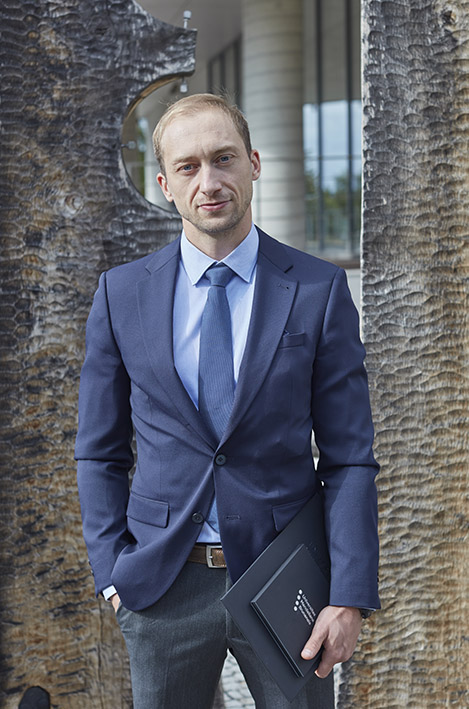
Petr Čermák, PhD
(Mendel University in Brno, MENDELU)
How did you arrive at your current position?
I started as a bachelor and later received a master's degree at Mendel University in Brno in 2006. I completed my master's studies in the Wooden Buildings and Elements program and decided to apply for a PhD position at the Department of Wood Science and Technology at MENDELU in Brno. I received a Doctor of Science degree in 2013. Subsequently, I applied for a postdoctoral position at the same institution and obtained my own funding for the next two years. During my postdoctoral studies, I acted as a visiting researcher at Aalto University in Helsinki, Finland, where I spent over 6 months. I became an academic staff member – junior researcher in 2015, actively engaging in research on wood modifications and teaching various courses for bachelor and master students. Meanwhile, I built strong connections with institutions abroad through several visits to Finland, Germany, Slovenia, Hungary, and others. I established a Wood Modification group and found my own funding. In 2021, I was awarded by the Rector of MENDELU for extraordinary research results in the field of natural and technical sciences for individuals under the age of 35. In mid-2022, I became the coordinator of the ASFORCLIC project and obtained an Associate Professorship in February 2023.
Which scientific question are you the most eager to answer?
Honestly, I do not have many deep scientific questions that I am eager to answer. Being a part of the Wood modification group, I was primarily interested in unraveling the behavior of wood-water interactions in modified wood within the multi-levelled structure of wood. I see my achievements more in applied results, developing new and innovative wood or wood-based materials with a specific set of physico-mechanical properties. These achievements could one day find their place on the market, either as modified facade elements or wood-based composites.
What is the future of your research?
Considering the current global climate change situation and its potential future impact on forestry, I anticipate an overall transformation of the forest-wood value chain. At least in the middle of Europe, we will have to find new technologies and applications for lesser-known wood species capable of adapting to the changed climate. I personally believe that wood science and technology research will become more multidisciplinary while still mainly focusing on sustainable and environmentally friendly products with extended service life, produced with a lower carbon footprint. As a society, we should be eager to use wood as a construction material, with the potential to build multi-level buildings, while legislative changes will be required. Alongside the traditional use of wood, we have to be open to new research directions, such as nanotechnology, where nanocellulose-based materials are opening up new possibilities in fields such as medicine, electronics, etc.
Open Science, especially Open Data, is highly debated on various levels. What is your opinion?
According to research calls, mainly from European projects, open data and data management plans, as well as gender equality plans, have become key requirements for project proposals, and this trend has solidified over the past years. I strongly support the idea that scientific research and data should be freely available to the public. By making research methods, data, and results accessible, we can promote transparency and reproducibility of our work. Furthermore, I believe that sharing research data enables scientists to build upon each other’s work, reducing duplication of efforts and therefore optimizing resources.
How do you maintain your work-life balance?
Maintaining work-life balance is crucial for my overall well-being. Considering that most of the time I spend is on the computer, the rest of my time is prioritized for staying as active as possible. My passion for travel and sports, mainly workouts, mountain hiking, or forest walks, becomes an easy way to escape from work duties and stay fit and healthy.
How difficult is it to have a career in science? How do you keep your motivation?
A career in the field of wood science and technology can be very rewarding on one side; however, it comes with its own set of challenges on the other. I personally believe that one of the most challenging aspects of a science career is funding-the never-ending process of finding resources for our own research, all while having lectures and other duties. I maintain my motivation primarily by staying in a positive environment surrounded by a motivated work team, seeking new challenges, and maintaining a balance between work and personal life.
How did you personally benefit from being a part of the ASFORCLIC consortium so far?
Being part of the ASFORCLIC project consortium offers various benefits depending on a personal point of view and role in the project. Twinning projects are focused on networking, therefore connection with professionals and well-recognized experts in the field of wood science and technology can potentially enhance my academic career, increase my visibility in the research community and help to develop a new set of skills. Being a coordinator of the ASFORCLIC project within the second reporting period comes with its own set of responsibilities, but it can also offer significant personal and professional benefits, mainly leadership and project management skills, decision-making and problem-solving processes, communication, and much more.
![]() This project has received funding from the European Union's Horizon 2020 research and innovation programme under grant agreement N°952314.
This project has received funding from the European Union's Horizon 2020 research and innovation programme under grant agreement N°952314.
